How Joey Carbery could help Andy Farrell's Ireland to be less 'predictable'
The Munster playmaker is the ideal man to act as a second playmaker in the backline.
by Murray KinsellaUpdated 20 hours ago
AMONG THE FRUSTRATIONS for Andy Farrell during this year’s truncated Six Nations was not being able to call on Joey Carbery’s skills.
The 24-year-old Munster playmaker, who has had a torrid time with injuries, could be central to making Ireland a far more dangerous attacking force in the future.
One of Ireland’s issues since the start of 2019 is that opposition teams feel they have a good grasp of what’s coming.
Although we were left with somewhat limited evidence due to the Six Nations being cut short, it was clear that Farrell and his attack coach Mike Catt are already moving to address this.
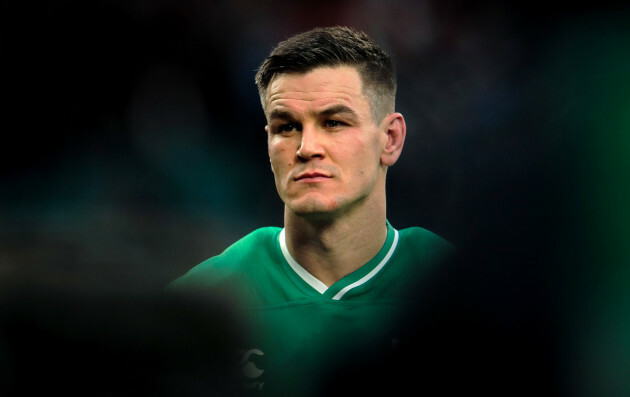
They’re pushing Ireland towards a new 1-3-2-2 shape that aims to allow them to operate with more width, while there also appears to be a greater freedom on counter-attack.
But still old perceptions persist. Speaking on The Magic Academy podcast in April, England out-half George Ford was asked an open-ended question about defence and wandered into providing an honest appraisal of how Eddie Jones’ side view Ireland.
“There’s teams that are very dominant who play off 10,” said Ford. “A team like Ireland is ‘Where’s Sexton? Where’s Sexton?’
“Wherever Sexton is, is where the ball is going.
“I suppose from an attack point of view, it’s interesting that you don’t want to probably be as predictable as that in terms of… you want to have the ability to go either side or either way with different options.
“The big thing that we learned in the Six Nations games was where we had some real good targets on lads in the opposition who our lads went after, the sort of talismen that the lads went after to stop the momentum of them really.”
To be fair, it’s not breaking news from Ford in underlining just how much playmaking responsibility lies on Johnny Sexton’s shoulders with Ireland.
Most out-halves in the world are the dominant forces in their team’s attack, of course, but this year’s Six Nations showed us once again just how much everything passes through Sexton.
In order to measure how reliant Ireland remain on Sexton as their main playmaker, we tallied up the number of times a backline player other than Sexton received the ball as first receiver and passed to a team-mate in this year’s Six Nations.
It happened just nine times over the course of Ireland’s three fixtures when Sexton was on the pitch as the team’s out-half.

Robbie Henshaw stepped up on four occasions to pass the ball from the first receiver position, while Jordan Larmour did it twice. Bundee Aki, Garry Ringrose [who played only 40 minutes before injury ended his Six Nations], and Keith Earls all had one involvement each.
In contrast, Sexton passed from the first receiver position 41 times, while also carrying himself eight times and kicking eight times.
This is a simplistic way of quantifying things, but the crux of the issue is that Ireland usually don’t have a genuine second playmaker on the pitch along with Sexton, someone who can take on creative and game-management responsibilities.
It’s no accident that many of the top teams now operate with dual playmakers. Defences at Test level are incredibly oppressive so attacks need to be able to keep them worrying about several threats.
England have Ford and inside centre Owen Farrell, while New Zealand used Richie Mo’unga and fullback Beauden Barrett at the World Cup, having operated with Barrett and fullback Damian McKenzie before that. Even South Africa have a fullback who is an adept second playmaker in Willie le Roux.
While Ringrose has been encouraged to use his creative skills more, Ireland haven’t really pursued the dual playmaker model, although Carbery’s unfortunate injury issues have possibly prevented it from being explored more under Joe Schmidt.
More recently, we did get a hint of what it might look like for Ireland.
Farrell’s men had a very tough day in Twickenham back in February, but they did finish out the game with late spurt of attack that left Farrell and Catt with plenty of food for thought.
Backline injuries meant Sexton shifted out midfield, with Ross Byrne coming on at out-half. England losing focus with the game already won played into it, of course, but Ireland’s attack looked sharper with this dual playmaker combination.
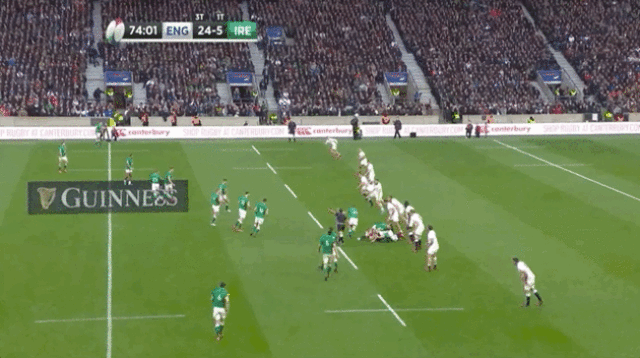
[Click here if you cannot view the clip above]
We get an example above, as Byrne gives second receiver Sexton a little more time on the ball and the 34-year-old fixes Ford before pulling a pass behind Aki to Earls, leaving Ireland with a 3-on-2 out on the left edge.
Earls makes a lovely pass to Stockdale to send him racing up the touchline before the Ulster wing links back inside to John Cooney running a clever support line.
One of Ireland’s longstanding issues in attack is that when Sexton is in a ruck or on the ground, there’s often not a whole lot going on.
In the three Six Nations games this year, there were 16 occasions on which backline players other than Sexton carried from the first receiver position during phase play.
There were certainly instances where some of them could have passed – where Sexton would have passed – but it’s not a comfortable place to be, particularly with defences bringing so much linespeed now. Tucking the ball and carrying is easier – the thinking might be, ‘Johnny will be back on his feet on the next phase.’
But late on against England, we had a prime example of what having a second playmaker on the pitch can provide.
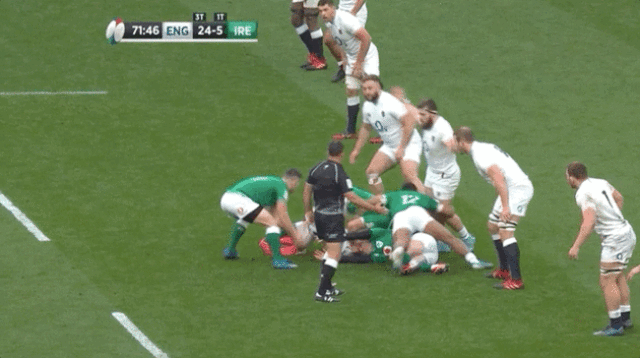
[Click here if you cannot view the clip above]
Sexton is on the ground here, having supported Earls’ carry.
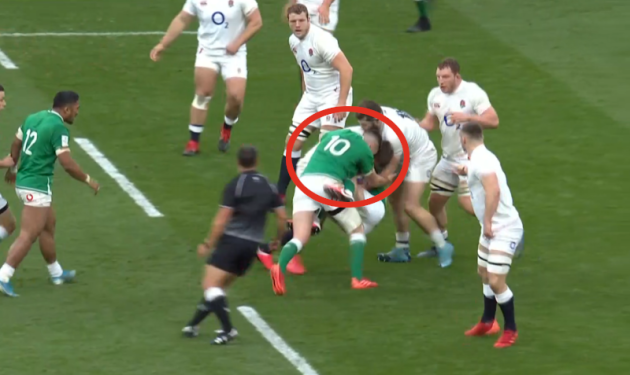
Byrne is at first receiver and as he gets on the ball, Maro Itoje races up on the edge of the defensive line looking to close off Byrne’s passing options.
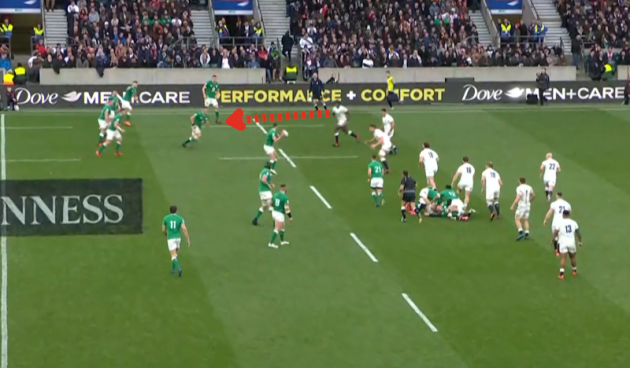
Itoje and England put major pressure on Ireland’s attack in this manner at Twickenham and another player might have simply opted to tuck and carry or play a short pass.
But out-half Byrne its more accustomed to making decisions and passing under this kind of pressure, so he is calm in playing the ball in behind Itoje to Caelan Doris, who breaks upfield and links inside to another sharp Cooney line.
These moments come against an England team that had taken the foot off the pedal, but they offer glimpses of the possibilities for Ireland with two playmakers on the pitch.
25-year-old Byrne continues to improve and is certainly a contender if Ireland shift to his model more permanently, but Carbery is obviously in that category too if he can regain full fitness after recent wrist and ankle surgeries.
While the Athy man is Munster’s first-choice out-half, he has lots of history at fullback and could provide Ireland with something very different in the number 15 shirt.
It’s worth remembering that Carbery had more starts at fullback [15 in total] than at out-half [11] for Leinster at senior level, with 90% of his starts in his final season with the eastern province coming in the 15 shirt.
With Sexton the main man at out-half and Byrne emerging strongly, it was clear that Stuart Lancaster and Leo Cullen viewed Carbery as being their possible long-term fullback after Rob Kearney. Instead, Carbery ended up as Munster’s main man at 10.
Looking back at his performances as a fullback with Leinster, it’s easy to see what could be possible for Ireland if they can get Carbery into the team as a second playmaker.
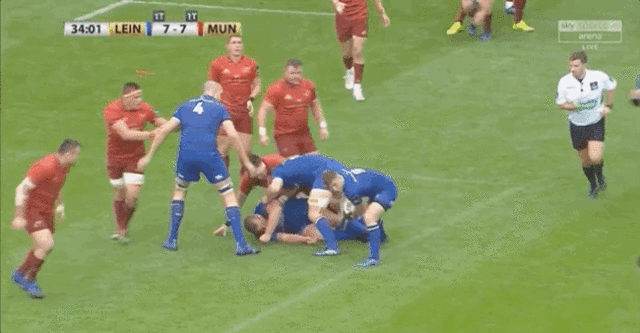
[Click here if you cannot view the clip above]
Carbery [white below] is initially positioned in behind a two-man pod of forwards set up to the left of Sexton [red] against Munster here.
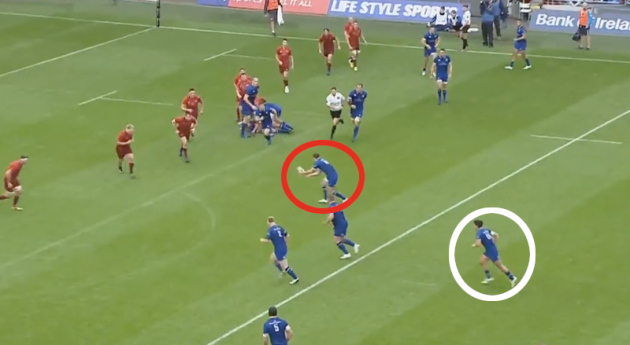
But as Sexton plays a short pass to Tadhg Furlong and takes off on a loop line behind the tighthead, Carbery intuitively reads his out-half’s intentions and also starts to shift diagonally across the pitch.
That takes him behind Scott Fardy’s intelligently direct line [yellow below], allowing Sexton to pull the pass behind to Carbery [white] as Peter O’Mahony is attracted inwards onto Fardy’s line.

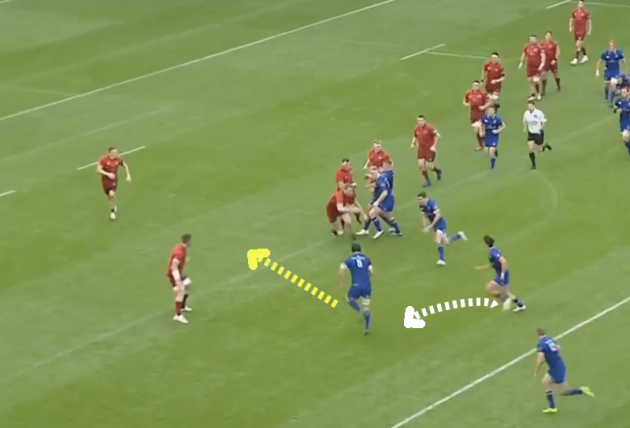
It’s a fluid bit of play between the Leinster 10 and 15, leaving Carbery free to accelerate into the gap and then calmly deliver the scoring pass to Rory O’Loughlin.
Carbery’s passing range is one reason he is such a good out-half, but that skill set can be equally effective slightly wider out the pitch too.
We get an example against Wasps below as Sexton pulls the ball behind Fardy again, leaving Carbery with time to deliver a stunning assist for Isa Nacewa.
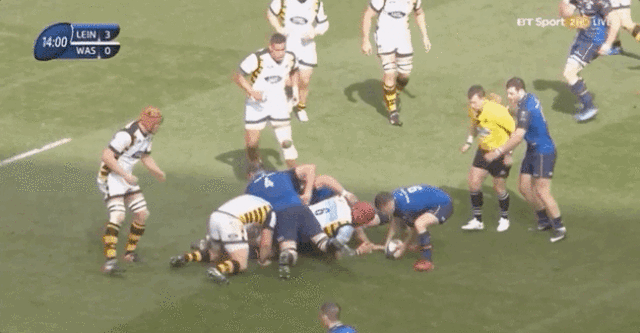
[Click here if you cannot view the clip above]
As well as the technical qualities of his pass, it’s Carbery’s decision-making that is so exciting in terms of the possibilities he offers as a second playmaker.
Sexton is an elite decision-maker but to have another player of Carbery’s decision-making ability in the backline would only serve to accentuate that.
Of course, Carbery is very comfortable as a first receiver and this is one of the most attractive parts of his potential as a second playmaker for Ireland from fullback.
In the instance below, Sexton is on the ground in the ruck for Leinster and Carbery steps up to deliver a pass that possibly no one else in the team apart from Sexton would have.
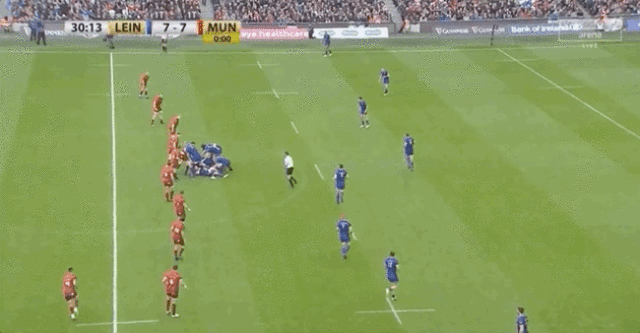
[Click here if you cannot view the clip above]
Having a genuine second playmaker in the backline also allows a team to “have the ability to go either side,” as Ford alluded to.
England can have Ford on one side of the ruck, with Farrell on the other – leaving the defence with concerns on both sides. A two-sided attack is something every coach aims for.
As we see below, Carbery at fullback can help deliver that for his team.
Initially, Leinster play off the touchline through out-half Byrne for Jack Conan to carry.
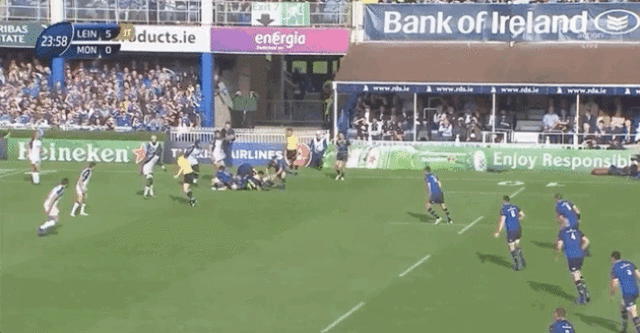
[Click here if you cannot view the clip above]
Byrne continues infield in order to set up for the next phase and we can see below that he’s organising as he goes, ready to play to the left of the ruck.
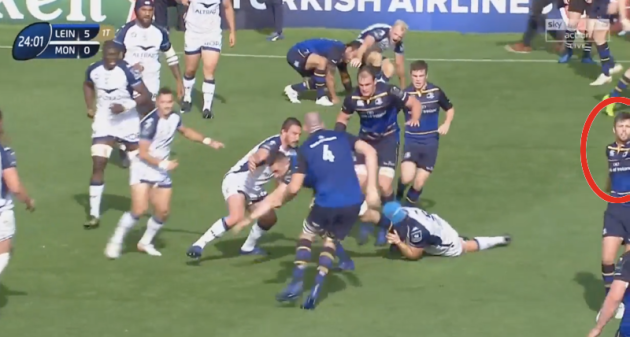
But in the meantime, Carbery has come from the touchline to set up to the right of Conan’s carry, providing Leinster with an option on that side too.
Scrum-half Luke McGrath bounces back there and Carbery throws another excellent pass to put Adam Byrne into space.
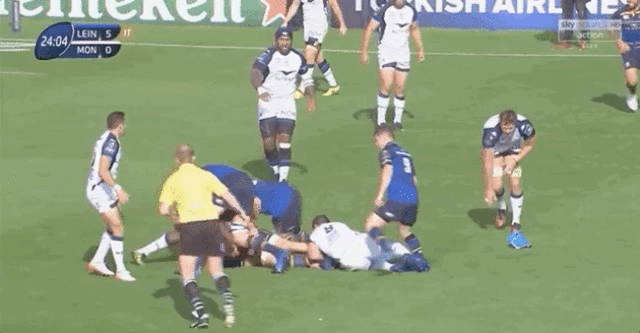
[Click here if you cannot view the clip above]
As well as in open play, Carbery’s presence as a second playmaker allows him to provide a threat on the other side of scrums too.
Below, we can see Sexton [red] on the right, with Carbery [white] to the left.
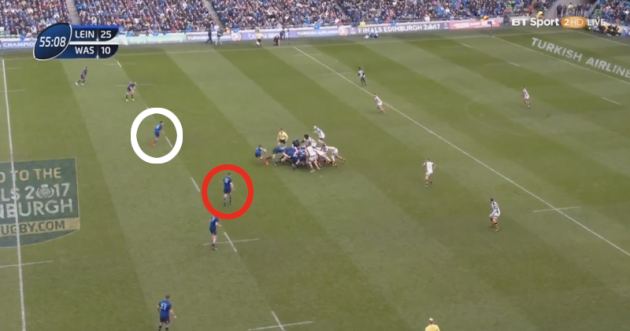
It’s worth pointing out that Carbery is a major threat with ball in hand himself, whether at 10 or 15.
During his time as a fullback with Leinster, he showed he is comfortable and effective at returning kicks, with his footwork allowing him to beat defenders.
As we see below, he has the pace to get outside opponents too, breaking off Byrne’s excellent long pass in this instance.

[Click here if you cannot view the clip above]
Another important factor is Carbery’s kicking quality.
Ireland’s attacking kicking game has been slightly inconsistent at a time when this area of the game has been rapidly developing in importance.
Carbery as a second playmaker from fullback could obviously add hugely to this area of Ireland’s game, while also relieving some pressure on his out-half.
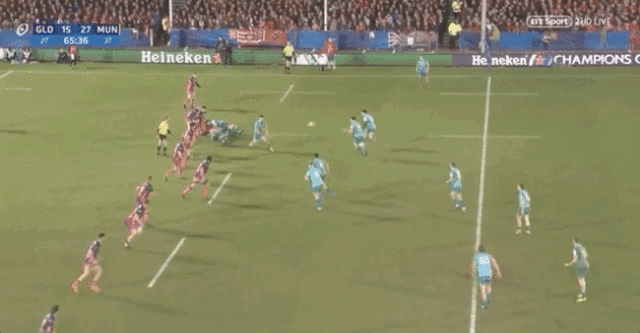
[Click here if you cannot view the clip above]
The example above comes with Carbery in Munster’s number 10 shirt but it’s easy to imagine him providing similar touches from 15.
Carbery also has experience of defending at 15, although very little of it at Test level – something that would have to be considered too. The Munster man is a willing tackler and intelligent in reading play but defending at fullback is a big job.
It’s worth noting that the grubber kick above was one part of a superb performance at out-half from Carbery, perhaps one of the best displays in his career and arguably the best Munster performance under Johann van Graan as they beat Gloucester 41-15 away in the Champions Cup last season.
Having stood out at 10 for Ireland too, Carbery is already an excellent out-half and it’s clear that ex-Ireland head coach Schmidt saw him as Sexton’s eventual successor.
Carbery’s six Test starts for Ireland so far – all under Schmidt – came at out-half. He did play at fullback on a handful of occasions, including a 50-minute stint off the bench on his second cap against Australia in 2016, when Ireland were hit with backline injuries.
More recently, Carbery played 54 minutes at fullback against the US in November 2018 as a result of injuries after he had started at 10, with Byrne coming on at out-half.
In total, Carbery has spent 112 minutes at fullback for Ireland in Test rugby, so it’s not a huge amount.
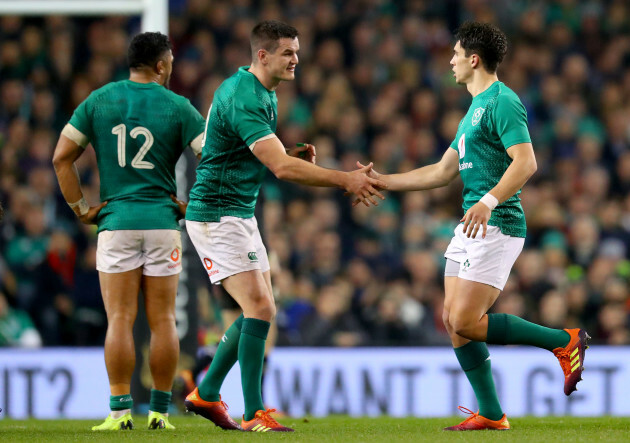
Of course, Ireland have a major prospect at fullback in 22-year-old Larmour, who started all three games in this year’s Six Nations in the 15 shirt and has huge room for growth in his already exciting game.
Larmour is being encouraged by both Leinster and Ireland to become more comfortable in acting as a second playmaker, using his passing and kicking skills to complement his obvious ability to beat defenders with his footwork and acceleration.
Ensuring his development continues is important for province and country, although Larmour already has lots of experience on the wing too.
Meanwhile, out-half Byrne’s development is worth consideration for Ireland as they move forward too. He has been an impressively consistent performer for Leinster in recent seasons and has worked hard to improve his attacking decision-making and physicality.
But Carbery’s game-breaking abilities mean he will surely be an important part of the picture for Ireland when he is fully fit again.
Whether Carbery wearing the 15 shirt might stunt his development as an out-half is an interesting debate but it’s clear that he will get the minutes at 10 with Munster whenever fit.
If an out-half of the calibre of World Rugby player of the year Barrett is being picked at fullback by the All Blacks and Farrell is playing at inside centre for England, it shows that even the very best 10s can adapt in a bid to make their team stronger.
As Farrell’s Ireland look to evolve beyond being seen as “predictable” by opposition teams, Carbery as a second playmaker could well be the key to offering something different in attack.
First published today at 19.28